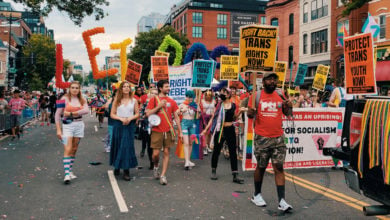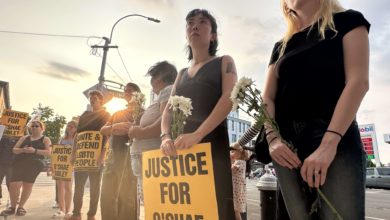The struggle for same-sex partner rights—legal recognition of lesbian and gay relationships—began in the United States in the 1970s. Following a 2003 Supreme Court victory in the Lawrence v. Texas case that confirmed the legality of same-sex relations, the demand for full marriage rights began.
 Photo: Krista Kennell |
Since that time, steady advances have been made, both in the United States and around the world. On Dec. 1, 2005, South Africa’s highest court recognized the marriage of two women and mandated that Parliament must extend the right to all same-sex couples within a year. (Washingtonpost.com, Dec. 2)
In December, Northern Ireland, Scotland, Wales and England joined about a dozen other countries in permitting same-sex civil unions. Full same-sex marriage rights have been won in the Netherlands, Belgium, Spain, Canada and the U.S. state of Massachusetts. (BBC News, Dec. 5)
Right-wing opposition to same-sex marriage, especially in the United States, has made the issue a subject of intense struggle. Many courts, legislatures and voter initiatives have confronted the topic, frequently blocking or reversing hard-won gains and rights.
But the right wing is having trouble trying to muster the supporters and funds needed to succeed in its opposition. In California, right-wing activists only managed to gather less than half the signatures required to put a conservative initiative to ban same-sex marriage on the ballot. (LA Times, Dec. 28, 2005)
This in part is because a majority of people in the United States believes that same-sex couples should be allowed various degrees of partnership rights, and also opposes a constitutional amendment outlawing marriage. This majority grows significantly among people in the 18-29 year-old age bracket.
These changing attitudes are the result of the modern LGBT movement, born out of the 1969 Stonewall Rebellion in New York City. It is through the many struggles for basic democratic rights fought for by LGBT people and their allies that more people have been educated about LGBT issues and accept the idea of LGBT rights.
If majority opinion alone determined the outcome, soon same-sex marriage would automatically be the norm. But changing opinions alone cannot usher forth such a monumental social change as widespread same-sex marriage rights. It is only the determined struggle of the LGBT movement and its allies that can win concessions from the ruling class, which in turn is reflected in mass opinion.
Marriage and economics
That struggle can be advanced by understanding the scientific social basis for LGBT rights.
Social relations, as understood by Marxists, are ultimately a reflection of economic relations. The economics of the family unit are in turn impacted by technological and scientific developments.
 Frederick Engels at age 20. |
Frederick Engels, a co-thinker of Karl Marx, issued a seminal examination of the family and social relations in his 1884 book, “The Origins of Family, Private Property and the State.” He tracked the development of social relations to the technology employed to provide food, other necessities and later goods to a society.
Mother-right or matriarchal societies, tracing the lineage of the family through the mother, existed under classless systems where scarcity dictated the necessity of sharing and cooperation. Technological advances made methods such as animal herding and agriculture productive, making it possible to accumulate more than was minimally necessary to sustain life.
As the productive level of society matured from conditions of generalized absolute scarcity to the creation of relative surplus, the collective social norms gave way to the private appropriation of the surplus. Over the course of a long period of time, social and family relations based on collective ownership and mother-right were replaced by father-right and class society. Repressive patriarchal laws and customs to control wealth also emerged. This ushered in the systematic oppression of women and homosexuals in society, which was previously unknown.
In the 1848 “Communist Manifesto,” Marx and Engels described how the family has been impacted under capitalism. “The bourgeoisie has torn away from the family its sentimental veil, and has reduced the family relation into a mere money relation.” For the ruling class, the “family” is nothing more than a legal arrangement to maintain ownership of wealth through inheritance. For workers, intimacy and companionship is battered by the pressures of earning wages to survive and the norms of exploitation that are often reproduced within the family unit.
Society changes, family changes
Extending Engels’ theory of social and economic developments to the 20th century, rapid economic development in the United States provided the backdrop for social developments, especially on the part of women, families and LGBT people.
At the turn of the 20th century, agriculture played a major role in the U.S. economy. With the technology at the time, many hands were needed to do the work, sustain life and perhaps improve one’s living conditions. Large and often extended families were the norm.
After industrialization in the early part of the century, the population became more urbanized. People often worked in factories, shops or offices. Sometimes one person might earn enough to support a family. The necessity or benefit of a large family was eliminated.
During the period of the 1930s through the 1960s, workers’ productivity skyrocketed by way of all manner of technological and scientific developments. Modern technologies for the home opened the possibility of reducing the daily drudgery of household chores that are required of many women, a form of unpaid labor that has been the backbone of women’s oppression under capitalism.
Yet absent a mass movement, these technological improvements actually intensified women’s oppression. Vast advertising campaigns tried to paint a picture of technology making women’s drudgery enjoyable, with the goal of making any woman who refused her “role” in the sexist division of labor to seem irrational or against progress.
This era was marked by the emergence of the bourgeois nuclear family, often depicted in modern culture as the norm. It consisted of a heterosexual couple and their children. The woman was responsible for the home and children, while the man was responsible for earning a salary.
Throughout these periods, LGBT people existed, but primarily lived their lives under cover, fearful of reprisal or physical violence, and were often marginalized. Those who could not or would not hide their transgender or homosexual orientation were attacked, maligned, ostracized and sometimes even murdered. This systematic oppression of LGBT people, along with women’s oppression, was part and parcel of bourgeois social relations.
During the 1960s and 1970s, women entered the workforce by the millions. Great scientific and technological advances took place, including reliable birth control and safe abortion procedures.
These developments coincided with a tremendous revolutionary political upsurge around the world and in the United States. National liberation struggles were sweeping Asia, Africa and Latin America. The Civil Rights movement was challenging racist Jim Crow apartheid laws in the South, ultimately emerging into a full-fledged Black liberation movement north and south. Millions were radicalized by the U.S. war against Vietnam. More and more people began to challenge the many forms of oppression that characterize U.S. capitalism—including racism, sexism and anti-gay oppression.
All these factors made possible real gains in the status of women that eroded the traditional, male-dominated nuclear family. Divorce laws were liberalized. Abortion was made legal in 1973.
These changes cannot in and of themselves undo the basic patriarchal, sexist and anti-LGBT oppressions that are part and parcel of capitalist society. As long as society is organized around the oppression of a vast majority by a tiny elite, special forms of oppression are necessary to divide the working class and extract super-profits from sections of the working class.
For example, sexist ideology fosters anti-women violence in the form of domestic violence and rape. The widespread character of this violence undermines many of the gains made by women.
This is also the case for LGBT couples that are trying to win and maintain same-sex marriage rights. On the one hand, modern reproductive science has diminished the social-biological need for the heterosexual family as the exclusive unit for having children and raising them.
On the other hand, anti-gay violence still forces many LGBT couples to hide their relationships and prevents them from living openly—not to mention “legally”—as a recognized couple.
Struggles ahead
 Revolutionaries advocate for same-sex marriage rights to build working-class unity. Photo: Bill Hackwell |
The fight for same-sex marriage rights is for LGBT people to win limited but basic rights that heterosexual couples enjoy, such as the right to adopt children, rent or buy homes together and function as traditional family units. It is an attempt to roll back or minimize the violence, bigotry and oppression painfully inflicted by the bourgeois social norms, short of overthrowing them—and to be recognized as equal. This struggle for civil rights is in the interests of all working people.
The laws and customs of society change in the same way that the conditions that shape the family structure change. The ruling class, though, is faced with a contradictory situation. It has created the conditions that make the heterosexual male-dominated family of yesteryear obsolete, but still desperately wants that same social order to remain intact, with its sexist, homophobic, racist, repressive and discriminatory characteristics.
This is because in fact the ruling class benefits materially from those repressive characteristics. It wants to cling to the divisive aspects of the social order, fragmented along false lines, so as to maintain control over society’s wealth. Were it not for these divisions, the majority of society, the working class, would find it easier to unite in opposition to the ruling class’s domination.
It is the emergence of a predatory class society with a minority controlling the wealth that introduced systematic women’s and LGBT oppression. Many struggles have won tremendous gains towards eliminating such discrimination. But these gains must be defended constantly and repeatedly, as they are counter to the interests of the capitalist ruling class.
For LGBT couples to be able to live free from discrimination and violence, society needs to be completely reorganized on the basis of human solidarity and cooperation. Socialism—an economy based on human need instead of private profit—lays the foundation for a truly liberated family, whether heterosexual or same-sex.
That said, the struggle for same-sex marriages and partnerships provides an avenue for building working class solidarity and challenging ruling class anti-gay, anti-woman ideology.
Articles may be reprinted with credit to Socialism and Liberation magazine.






